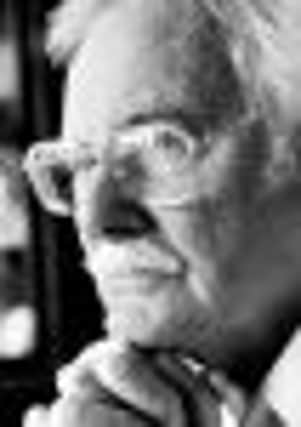Eric Lomax: 1919-2012


IN March 1939, Eric Lomax was a handsome, dark-haired 19-year-old, working for the Post Office in his native Edinburgh and planning to marry his childhood sweetheart, when Hitler invaded Czechoslovakia. With war looming, young Eric postponed his marriage plans and volunteered for the Royal Corps of Signals, first attached to the 5th Field Regiment, Royal Artillery. His parents and girlfriend were proud and hoped he’d be back in Edinburgh soon. That was not to be.
Almost three years later, in February 1942, 2nd-Lieutenant Lomax was among the thousands of British forces who surrendered to the Japanese in Singapore and were force-marched to Changi, on the eastern tip of the island.
Advertisement
Hide AdAdvertisement
Hide AdFor three-and-a-half years, he suffered daily torture at the hands of his captors, notably while working on the Burma-Siam railway – the ‘Death Railway’, including the bridge made famous in the film ‘Bridge on the River Kwai’. Speaking of the film, Lomax would have assured you it was “baby-lotioned” to make it acceptable for universal release. What he and his fellow prisoners really went through would not have made it through the movie censors.


When he returned to Edinburgh in 1945, by then promoted to captain in the Signals, he was not the same man. Though he’d been half-starved throughout the war, his body had survived. His mind was another matter. “If you are a victim of tortures, you never totally recover,” he said years later. “You may cope with the physical damage, but the psychological damage stays with you forever. In 1945, I returned to Edinburgh to a life of uncertainly following three-and-a-half years of fear, interrogation and torture… I had no self-worth, no trust in people, and lived in a world of my own. The privacy of the torture victim is more impregnable than any island fortress.
“People thought I was coping, but inside I was falling apart. I became impossible to live with; it was as if the sins of my captors were being harvested in my family. I also had intense hatred for the Japanese, and was always looking for ways and means to do them down. In my mind I often thought of my hateful interrogator. I wanted to drown him, cage him and beat him – as he had done to me.”
After retiring in 1982, Lomax decided to confront his demons. Through painstaking research, pre-Google, he learned that his interrogator and torturer, a Japanese soldier called Nagase Takashi, was still alive. “I learned that he was active in charitable works, that he had built a Buddhist temple. I was sceptical. I couldn’t believe in the notion of Japanese repentance. I strongly suspected that if I were to meet him, I’d put my hands round his neck and do him in.
Advertisement
Hide AdAdvertisement
Hide Ad“My turning point came in 1987 when I came across The Medical Foundation for Victims of Torture. For the first time I was able to unload the hate that had become my prison. Seeing the change in me, my wife wrote to Nagase. The letter he wrote back was full of compassion, and I think at that moment I lost whatever hard armour I had wrapped around me and began to think the unthinkable.”
In the 1990s, organised by Lomax’s wife Patti, the two men finally met, in Kanburi, Thailand. “He greeted me with a formal bow,” Lomax wrote. “He was trembling and crying, and said over and over again: ‘I am so sorry, so very sorry.’ I had come with no sympathy for this man, and yet Nagase, through his complete humility, turned this around. In the days that followed we spent a lot of time together, talking and laughing. It transpired that we had much in common. We promised to keep in touch and have remained friends ever since. After our meeting I felt I’d come to some kind of peace and resolution. Forgiveness is possible when someone is ready to ask for forgiveness. Some time the hating has to stop.”
For further catharsis, Lomax wrote his autobiography, ‘The Railway Man’ (1995), chronicling his torture. It is being turned into a film of the same name, partly shot in Scotland – in Berwick, Edinburgh and Holy Island – and starring Colin Firth as Lomax and Nicole Kidman as his wife Patti. The book won several literary awards.
The film, with later scenes to be shot in Thailand and Queensland, Australia, is due out next year and Lomax, just before he died, expressed how much he was looking forward to seeing it. Had he lived, he would have been the star attraction at the premiere. Having visited Lomax and Patti in Berwick, to work on the Scottish accent and the nuances, Oscar-winning actor Firth told The Scotsman he had been “overwhelmed” by meeting the man he was about to portray for posterity. While Firth will play the older Lomax, Jeremy Irvine (of ‘War Horse’ fame) will play the Scot as a young man in Edinburgh.
Advertisement
Hide AdAdvertisement
Hide Ad“Eric and Patti were both incredibly engaging, a delight, although I did feel at times a little overwhelmed by the enormity of the story,” Firth said. “He is 92 (at the time) and not really demonstrating that at all. He is mentally far more agile than I am.”
Eric Sutherland Lomax’s mother, Elizabeth, was from Lerwick, Shetland. An ancestor, John Suth-erland, was among more than 100 fishermen who died in the 1832 fishing disaster off the islands.
Eric Lomax is survived by his wife Patti and family.
PHIL DAVISON